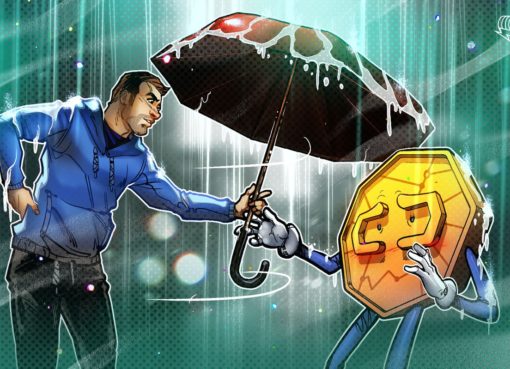We live in the days of next-generation digital money emergence. Ultimately, the world lacks a clean balance sheet and an asset that has significant appreciation potential to create more loans against it. Euro-backed stablecoins can help boost the crypto-lending sector by providing new ways to put both digital assets and fiat to work.
Crypto lending works similarly to traditional lending services, the core difference being that loans are issued on decentralized platforms that lock up cryptocurrencies via smart contracts deployed on public blockchains.
And while the up-and-coming decentralized finance sector has grown, with $452 million in funds locked up in smart contracts — a 200% year-on-year increase — the industry has the potential to reach higher adoption levels.
The remaining point of friction? Most crypto lending options incur high losses when exchanging between crypto and fiat currencies.
The rising opportunity
A euro-backed stablecoin can provide much more value for a crypto-enabled financial system, and to understand why, it’s important to first consider the role that Europe and the euro play in the global financial system.
Global debt markets overexploit the assets they derive from. The world’s largest asset classes are the global stock market, worth $85 trillion, and residential real estate, worth $217 trillion. Yet, global debt sits at $244 trillion, increasing the debt-to-asset ratio to 80%. This indicates that the world’s balance sheet is practically living off leverage.
In comparison, the cryptocurrency market has about $200 billion in assets with a debt-to-asset ratio of 2%, indicating a massive upward potential for a crypto-collateralized lending industry without necessarily having the same debt-to-asset balance sheet mismatch as traditional lending. With the crypto lending industry relying heavily on overcollateralization, lenders can only issue debt on a fraction of collateralized assets.
Euro stablecoins: a viable option for crypto lending
Until the crypto lending sector takes a considered approach to minimize price volatility between the value of fiat and cryptocurrencies, lenders and borrowers are faced with significant risks.
We can’t forget that the smart contracts that power crypto loans are self-executing lines of code. Securing a loan would involve sending cryptocurrencies to a smart contract escrow on the blockchain that will only release the collateral when the debt is repaid.
This means that movements in the value of a cryptocurrency in relation to a fiat’s value could trigger the smart contract to liquidate a loan.
In theory, stablecoins would be the best-fitting solution, as they are pegged to the value of existing fiat currencies. However, when looking at stablecoins pegged to the United States dollar, it quickly becomes apparent that they represent a limited solution that only serves a landlocked market. As other stablecoins continue to emerge, the market share of dollar-backed stablecoins will inevitably rebalance down.
The best candidate for an alternative to dollar-backed stablecoins is one backed by the euro, for a number of key reasons.
When we take a look at the stability of the traditional markets, the Eurozone has a strong economy comparable to the U.S. by population size, GDP and worldwide trade. Its current account balance is positive, at 1.18% of GDP as compared to -2.40% of GDP in the U.S., and the fiscal deficit of the former is 7.0x lower than that of the latter. Overall, the euro looks more stable over the dollar as an underlying asset for both stablecoins and crypto lending.
The amount of people involved in cryptocurrencies in the EU is also comparable to the U.S.: 9% of Europeans own crypto (67 million people) compared to 8% of Americans (26 million people), according to CCN data. Yet, holders are forced to settle in dollars when selling cryptocurrencies, which is more expensive and carries significant FX risks. The EU market is totally underpenetrated at the moment and is rising from a low base. Non-U.S. citizens must also oblige to U.S. regulations when holding dollars, even if it is only transitory. Euro-backed stablecoins represent the reporting currency of crypto holders in Europe, and as such, mitigate all the risks and inefficiencies related to U.S. dollars.
Lastly, the euro has a killer advantage for borrowers holding crypto — the negative interest rate yield. So far, there are no crypto lending platforms that understand how to capitalize on this advantage. If used right, it can reduce current crypto borrowing rates by at least 3% and still offer an attractive euro-pegged deposit yield, as the latter is practically non-existent, at 0.0–0.3% per annum.
Capitalizing on crypto lending leverage
What’s surprising is that to this day, financial institutions do not have the ability to lend fiat currency against cryptocurrency. This is a major opportunity loss when considering the growing crypto asset class.
To take advantage of the opportunities around crypto lending with a euro-backed stablecoin, a platform would need to consider the infrastructure needed for it to succeed. This includes on- and off-ramps or instant fiat settlements as well as an already established and adopted euro-backed stablecoin with meaningful liquidity.
It is also important that an issuer accounts for counterparties who can accept a euro-backed stablecoin. For instance, having a connection with cashout points, Visa or Mastercard would allow users to instantly spend or withdraw cash in their day-to-day lives. Corporate settlement projects are another important consideration that will help with managing balance sheets between decentralized finance applications and traditional institutions.
But what about price volatility? To a certain extent, volatility that matches real-world markets can be a real positive for a crypto lending platform, which may capitalize when liquidations are triggered.
As a fiat derivative, euro-backed stablecoins could make a currency truly borderless and more global than ever. Individuals all over the world could gain exposure and synthetic access to the benefits of the euro, which has been largely limited so far to people within Europe.
It is also worth re-emphasising that crypto trades are not limited to markets and timezones. Bonds don’t always trade every day and equities don’t trade on weekends or nights. In comparison, illiquid assets like real estate, which is typically only traded every one to five years, can be given new life.
With the crypto lending market growing at an astounding rate, it is guaranteed to disrupt the traditional finance sector even further. But for it to make a meaningful and long-lasting impact, a real stability of the underlying asset is a must. Fiat-backed stablecoins might just be the right solution. Among the hundreds of announced projects, EURS is the only game-changer that is crafted with regulations and still working successfully.
The views, thoughts and opinions expressed here are the author’s alone and do not necessarily reflect or represent the views and opinions of CryptoX.
Gregory Klumov is a sought-after stablecoin expert whose insights and opinions appear regularly in numerous international publications. He is the founder and CEO of STASIS, a technology provider that issues the most widely used Euro-backed stablecoins with the highest transparency standard in the digital asset industry.




